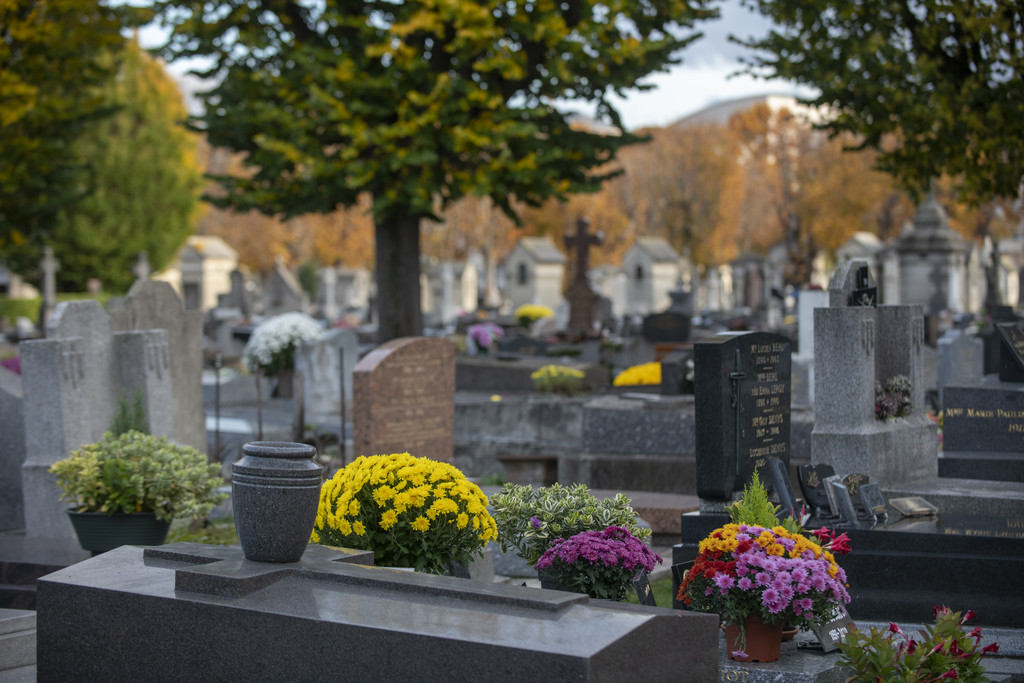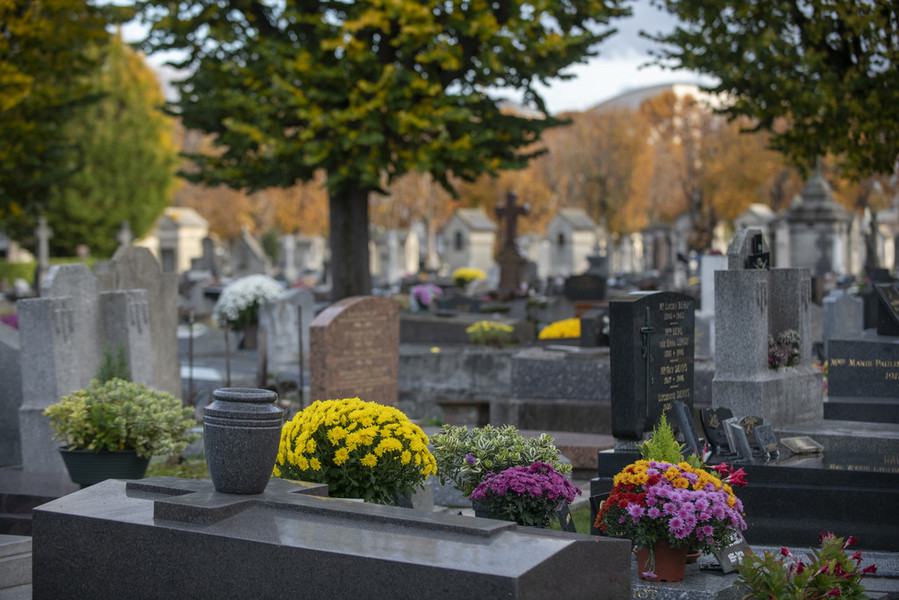
The old cemetery

With the expansion of the town, the cemetery, which was located in Place de l'Église until 1815 and then in Avenue d'Argenteuil (around number 17), was moved to Rue du Ménil in 1861.
On 23 December 1876, the town council decided to rename departmental road 14, created in 1867, Boulevard Voltaire. At the same time, rue de l'Alma was extended to the entrance of the cemetery.
At the turn of the century, only the odd sides of this street were built on. Next to the cemetery, the Guillemin marble factory was followed by the "Bière de l'Espérance" café-restaurant, opposite a hotel-restaurant. The cemetery has been enlarged several times. It was first extended to rue des Bas in 1882, then in 1922 to create an area for a military cemetery (162 graves).
The north wing was built in 1942 at the cost of 8,560 m² of market garden, and the south wing in 1950.
A number of prominent figures from the world of arts are buried in Asnières. Among the many "residents" of the cemetery are:
Grave of the Bidel and Rancy families
The Rancy Circus was founded in Rouen in 1856 by Théodore Rancy (1818-1892), a born performer and excellent horseman. His partnership with François Bidel (1839-1909), a renowned animal trainer and menagerie director - "a lion among lions", in the words of Victor Hugo - heralded the golden age of the French circus. After the death of the patriarch, his son Alphonse Rancy (1861-1932) took over the management of the circus, accompanied by his wife, the daughter of the trainer Bidel. In 1904, the circus moved to Asnières. The circus flourished until the First World War, with around a hundred horses, lions, elephants, a corps of twenty-five dancers and a marquee that could hold 2,600 spectators. The procession toured France until the 1940s. The descendants of the two families have continued the Traveller tradition ever since.
Achille Lemot
(1846-1909), known as Uzès, was an illustrator, vignette painter and caricaturist. He lived and died in Asnières.
Auguste Thin
(1899-1982), the 2nd class in charge of identifying the body of the Unknown Soldier on 10 November 1920, lived in the Bourguignons district. He is buried in Asnières.
Alfred Adam
Actor, born in Asnières on 5 April 1908, died on 7 May 1982. He is buried in Asnières.
Jean dit Eugène Claude
Painter, 1841-1923, lived at 90 rue de Châteaudun. Died and buried in Asnières.
Paul Petit Demange dit Paul Demange
Actor, 1901-1983, is buried in Asnières.
Armand Numès, 1857-1933 et André Numès
Theatre artists, 1896-1972 deceased, in Asnières (6 avenue Casimir) and buried in Asnières.
The Vuitton family
Born on 4 August 1821 in Anchay (commune of Lavans-sur-Valouse, Jura), Louis Vuitton, son of a farmer, Xavier Vuitton, moved to Asnières in 1854 at 14 rue du Congrès, where he set up his workshop in 1860. He died on 27 February 1892 in Asnières. His son Georges-Férréol Vuitton was born on 13 July 1857 in Paris and died on 26 October 1936 in Asnières. His son Gaston-Louis Vuitton was born on 30 January 1883 and died on 18 March 1970 in Asnières. All three are buried at Asnières. Gaston-Louis Vuitton's two sons, Claude-Louis-Germain Vuitton (former deputy mayor of Asnières), who died on 10 January 1992 in Boulogne-Billancourt, and Jacques-Louis-Victor Vuitton, who died on 21 August 1964 in Paris Xe, were born in Asnières on 29 December 1923.
Gaspard Clair François Marie Riche
Baron de Prony, born in Chamelet (Rhône) on 22 July 1755 and died in Asnières-sur-Seine on 29 July 1839, was a French engineer, hydraulic engineer and encyclopaedist. He took his name from the seigneury of Prony, in Oingt (Rhône).
Spotlight on Georges Colomb
Georges Colomb, known as Christophe, 1856-1945, author of the Fenouillard family, is buried in Asnières.
Georges Colomb, better known as Christophe, is considered one of the pioneers of the comic strip, with characters such as the Sapeur Camember and the scientist Cosinus. Born in Lure on 25 May 1856, Georges Colomb is an emeritus professor of natural sciences at the Sorbonne. He was the author and illustrator of around thirty textbooks on natural and popular sciences.
He took the name Christophe Colomb in reference to another famous Christopher Columbus.
He lived in Asnières, 4 rue de Colombes, at the beginning of the 20th century. There is a street named after him in Hauts d'Asnières, near Boulevard Pierre de Coubertin.

Christophe, pioneer of the comic strip
It was Christophe who first introduced the principle of a strip of images above the text. It was not until 1908 that bubbles or phylacteries appeared in Les Pieds nickelés. He used this technique in several series that became famous, including La famille Fenouillard (1889), Les Aventures du sapeur Camember (1890), Le savant Cosinus (1893) and Les malices de Plick et Plock (1893).
La famille Fenouillard is often regarded as the first French comic strip. The story appeared as a serial in the children's weekly Le Petit Français Illustré from 1889. In its naïve guise, it was a biting critique of the customs of a provincial family who set out to discover the world.
The adventures of Sapeur Camember were published in serial form from 1890 to 1896. Undoubtedly his most famous character, Camember represented the brave and naive young country boy in the prestigious uniform of the Sapeur du Génie, confronted with the comic and absurd situations of military life. This character became famous throughout France and the town of Lure immortalised him by unveiling a statue of him in 1979.
"L'idée fixe du savant Cosinus" recounts the misadventures of a scientist who wants to travel around the world and invents the most absurd means of transport without ever leaving the gates of Paris. To create his hero, Christophe drew inspiration from scientists of his time, such as the mathematician Jacques Hadamard and the physicist André-Marie Ampère, who were known for their notorious absent-mindedness.
Christophe's work is characterised by a vocabulary rich in cultural, literary, historical and scientific allusions. Puns also play an important role in his humour, which is sometimes bizarre or satirical, but always full of irony and tenderness.
Christophe died on 3 January 1945 in Nyons in the Drôme, where he had taken refuge in 1940 to escape the German invasion.
